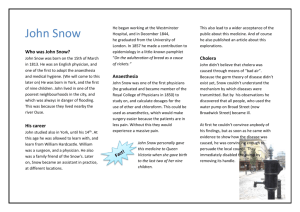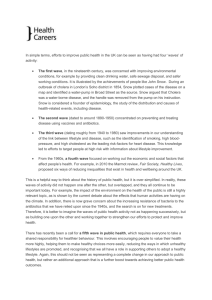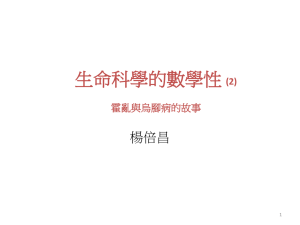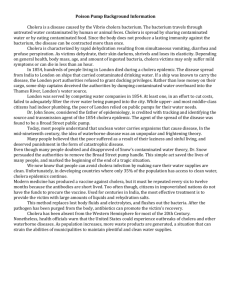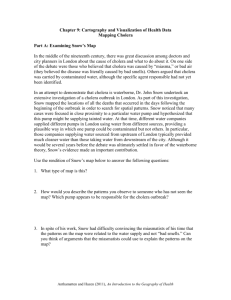John Snow's Contribution to Modern Epidemiology
advertisement
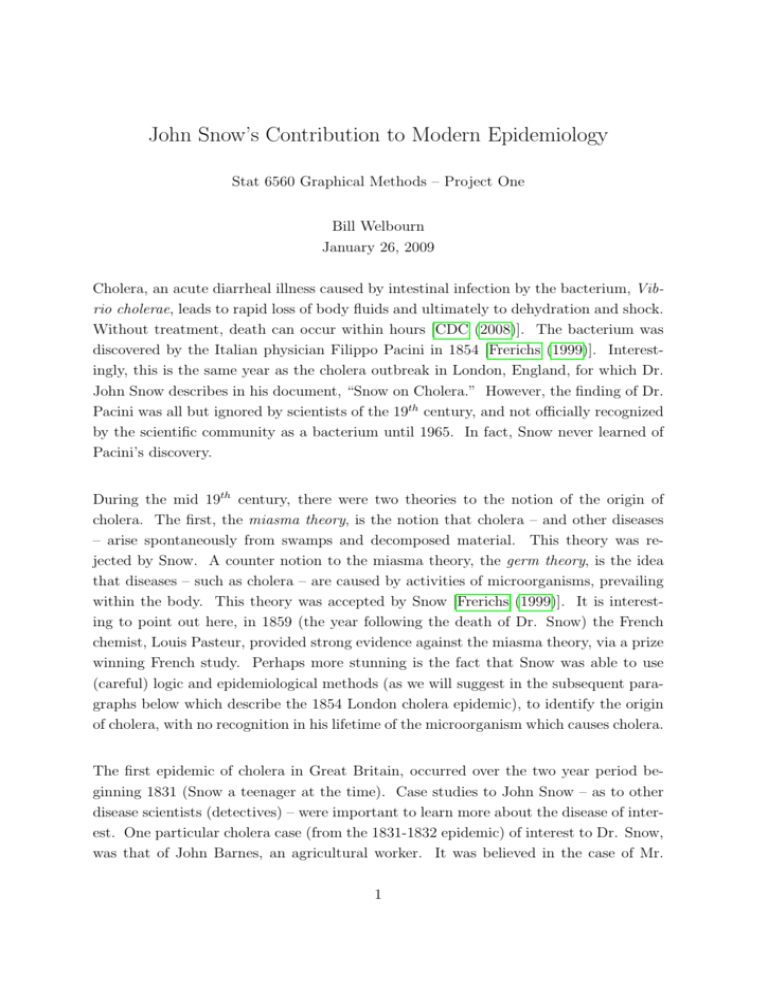
John Snow’s Contribution to Modern Epidemiology Stat 6560 Graphical Methods – Project One Bill Welbourn January 26, 2009 Cholera, an acute diarrheal illness caused by intestinal infection by the bacterium, Vibrio cholerae, leads to rapid loss of body fluids and ultimately to dehydration and shock. Without treatment, death can occur within hours [CDC (2008)]. The bacterium was discovered by the Italian physician Filippo Pacini in 1854 [Frerichs (1999)]. Interestingly, this is the same year as the cholera outbreak in London, England, for which Dr. John Snow describes in his document, “Snow on Cholera.” However, the finding of Dr. Pacini was all but ignored by scientists of the 19th century, and not officially recognized by the scientific community as a bacterium until 1965. In fact, Snow never learned of Pacini’s discovery. During the mid 19th century, there were two theories to the notion of the origin of cholera. The first, the miasma theory, is the notion that cholera – and other diseases – arise spontaneously from swamps and decomposed material. This theory was rejected by Snow. A counter notion to the miasma theory, the germ theory, is the idea that diseases – such as cholera – are caused by activities of microorganisms, prevailing within the body. This theory was accepted by Snow [Frerichs (1999)]. It is interesting to point out here, in 1859 (the year following the death of Dr. Snow) the French chemist, Louis Pasteur, provided strong evidence against the miasma theory, via a prize winning French study. Perhaps more stunning is the fact that Snow was able to use (careful) logic and epidemiological methods (as we will suggest in the subsequent paragraphs below which describe the 1854 London cholera epidemic), to identify the origin of cholera, with no recognition in his lifetime of the microorganism which causes cholera. The first epidemic of cholera in Great Britain, occurred over the two year period beginning 1831 (Snow a teenager at the time). Case studies to John Snow – as to other disease scientists (detectives) – were important to learn more about the disease of interest. One particular cholera case (from the 1831-1832 epidemic) of interest to Dr. Snow, was that of John Barnes, an agricultural worker. It was believed in the case of Mr. 1 Barnes, that the time from onset of cholera, to death, was three days. Two other Barnes family members became ill (subsequent to John Barnes’ illness) with cholera and died within two days. Moreover, it was believed that John Barnes acquired his illness, via physical contact of clothing worn by his infected sister (who later died from cholera). This single case study (of 1832) provided Snow with insight as to both, the incubation period of the illness, as well as how the illness spreads. Subsequent cases studies, led Snow to believe that cholera was spread from the sick to the healthy, but that not all persons in contact with infected individuals become ill. Moreover, Snow observed that to become infected, it was not necessary to be near another infected individual. Snow concluded that cholera commences with the affection of the alimentary canal. To suggest that Dr. Snow was a practitioner (in fact some (e.g., [Vachon (2005)]) suggest the father) in the field of epidemiology, we first need to define the term epidemiology. As defined in, A Dictionary of Epidemiology, epidemiology is, “The study of the distribution and determinants of health-related states or events in specified populations, and the application of this study to control of health problems” [Last (2000)]. The word control helps distinguish epidemiology from other fields of scientific practice. As we will see, his concern with control actions, helps explain why Dr. Snow’s work in the Broad Street pump area is honored by epidemiologists and other health professionals. Although Great Britain saw two prior epidemics of cholera – during the periods of 1831-1832 and 1848-1849, respectively – prior to the 1853-1854 epidemic, Snow writes in September 1854, “The most terrible outbreak of cholera which ever occurred in this kingdom, is probably that which took place in Broad Street, Golden Square, and the adjoining streets, a few weeks ago” [Frerichs (1999)]. Figure 1, displays a map of the Golden Square region [Snow (1936), Frerichs (1999)]. In particular, the non-shaded yellow (i.e., the white area of the map) region of the map, displays the area of London which interested John Snow during the August/September 1854 cholera outbreak. Snow continues in his paper, to discuss the severity of the August/September 1854 cholera outbreak, “Within two hundred and fifty yards of the spot where Cambridge Street joins Broad Street, there were upwards of five hundred fatal attacks of cholera in ten days. The mortality in this limited area probably equals any that was ever caused in this country, even by the plague... The mortality would undoubtedly have been much greater had it not been for the flight of the population” [Snow (1936)]. 2 Figure 1: John Snow’s rendition of the 1850 C.F. Cheffins Company Map [Frerichs (1999)]. The white section of the map shows the area of particular interest to John Snow. The area encompassing the Broad Street Pump is circled (blue). The location for which Dr. Snow makes reference to, within the aforementioned passage, namely, the joining of the two streets (Cambridge and Broad), is highlighted in Figure 1, via the blue circled region. Note that this passage by Snow demonstrates the severity of the outbreak. Within a ten day span of time, we find that the rate of fatal attacks of cholera was about fifty deaths per day. Moreover, Snow’s use of the phrase, “limited area,” suggests that the population in this region (Figure 1) of London is small, relative to the remaining area which comprises London. Finally, the fact that 3 some of the population of London fled the area, suggests that the mortality proportion of the population for the area (Figure 1) was quite high. Finally, note the detail Dr. Snow adheres to, within the aforementioned passage, painting an image of the severity, time, and exact location of this travesty. Figure 2, shown below, displays a time– series plot of the incident cases of cholera (red line) and the deaths from cholera (black line) in this region of London, as reported by Snow within Table I of page 49 of his manuscript [Snow (1936)]. The figure helps visualize the severity and sudden nature of the outbreak, and helps support Snow’s conclusion regarding the timing of the outbreak. Apparently, the “so-called outbreak” of cholera, essentially occurred overnight. Dr. Snow writes, making reference to the outbreak, “... commenced in the night between the 31st August and the 1st September...” Note that this observation of Snow is seen in Figure 2, as the incident cases of cholera sharply increase during the noted time period. Although Snow does not include details as to the reasoning (the initial instance for which he states the Broad Street Pump being the source of the outbreak), leading to the conclusion for which he came upon (e.g., why the Broad Street Pump?; and for that matter, why a water source for the cause of the outbreak?), he writes (regarding the outbreak), “As soon as I became acquainted with the situation and extent of this irruption of cholera, I suspected some contamination of the water of the much frequented street-pump in Broad Street, near the end of Cambridge Street; but on examining the water, on the evening of the 3rd September, I found so little impurity in it of an organic nature, that I hesitated to come to a conclusion. Further inquiry, however, showed me that there was no other circumstance or agent common to the circumscribed locality in which this sudden increase of cholera occurred, and not extending beyond it, except the water of the above mentioned pump.” An interesting observation to point out here, is the retrospective (i.e., the type of epidemiological observational study, as we would refer to today) nature of the conclusion of Dr. Snow, which provides the reader with a hint as to the epidemiological skill set he possessed. Namely, he tested the water of the Broad street pump, September 3rd, but the cholera outbreak occurred two days prior, on September 1st. He utilized a water sample in present time (9/3/1854), to draw a conclusion of the consistency of the water in the past (9/1/1854). Continued reading of the paragraph, for which the preceding quotation arose, we see once again the detail of Dr. Snow, and are introduced to the persistence of his cholera outbreak investigation. Namely, the water sample he took from the Broad Street Pump on September 3rd was not enough for him (i.e., he was not about to give up on his hypothesized notion of the Broad Street Pump water being contaminated). 4 Figure 2: Time-Series plot of the incident cases (red line) of cholera and deaths (black line) from cholera, for the time period, August 19, 1854 to September 30, 1854. The handle of the Broad Street Pump was removed September 8, 1854. He states, “... the water varied, during the next two days, in the amount of organic impurity...” Thus, we see that he drew several samples of the water each of the days, September 4th and 5th, so as to yield evidence supporting his Broad Street water contamination hypothesis. The procedure (water sampling) he followed over these three days of September 1854, is precisely the scientific methodology in which epidemiologists follow today – form a hypothesis(es) and carry out a procedure for testing it (them). Many neighborhoods in 19th Century England had pumps which provided water to residents. Figure 1, displays the locations of the thirteen pumps (as indicated by “” symbols) of interest to Dr. Snow. After inspecting the water of the Broad Street Pump, Snow requested permission (via the General Register Office) to take a list of the registered deaths due to illness from cholera. Recorded deaths are indicated by “black bars” 5 (e.g., |||||) within Figure 1. There were a total of eighty-nine recorded deaths from cholera, spanning the date range, August 28, 1854 to September 2, 1854, seventy-nine (89%) of which occurred on September 1st or September 2nd. Snow concluded that the outbreak begun, August 31st. Snow utilized the list of eighty-three deaths – registered beginning August 31st and ending September 2nd – and found that nearly all of these deaths occurred a short distance from the Broad Street Pump. Note the word “distance” in the preceding sentence, thereby demonstrating Snow’s use of graphical tools (i.e., Figure 1) in aiding with his inference. There were only ten deaths in houses situated to a nearer pump, five of which drew their water from the Broad Street Pump. In three other cases (children who went to school near the Broad Street Pump), two were known to have drank the water of the Broad Street Pump, and it was thought by Snow that the third child also drank the water of this pump. The remaining two cases, represent the existing mortality of cholera in the area. Snow continues to write (very detailed) accounts of interviews, tieing together facts linking the Broad Street Pump as the source of the cholera outbreak. The pump handle of the Broad Street Pump was removed on September 8th, as shown in Figure 2. The action (interview with Board of Guardians) taken by Snow, to have the pump handle removed, demonstrates the control portion of the definition of epidemiology. To this end, the investigation of Snow, shows that he was truly an Epidemiologist, as all actions he partook in the cholera outbreak investigation, adheres to – in its entirety – precisely the definition thereof. Figure 3, is a graphical portrayal of the relative locations of the cholera deaths from the thirteen pumps (the Broad Street Pump is located near the center of the figure, indicated by the red “+” symbol). The data utilized to generate the graph were obtained from http://www.ncgia.ucsb.edu/pubs/snow/snow.html. Note that the figure lacks units for the horizontal and vertical axes, due to the fact that the immediately aforementioned reference does not provide this (important) detail. Moreover, note that of the 578 deaths portrayed (by solid dots) in the figure, 359 (62%) occurred (black dots located within the polygon) at a distance closer to the Broad Street Pump than that of any other pump location. 6 John Snow’s actions during the August/September 1854 London cholera epidemic, were truly that of an modern day Epidemiologist. To begin, he formed several hypotheses regarding the dissemination of cholera, including: (i) the method in which the disease is spread from person to person. Snow believed this to be via the fecal-oral route; (ii) the incubation period for the onset of the disease is between twenty-four to forty-eight hours; (iii) the organism being able to reproduce itself within the infected host (person), and therefore must be cellular in structure; (iv) the importance of hygiene in relation to social class (i.e., the disease was spread through a lack of cleanliness, in which person who came into contact with a cholera victim, must also come into contact with the “invisible morbid material” for which cholera arises – involuntary passed stools which contaminated the victims linens and clothing); and (v) the water feeding the Broad Street Pump was contaminated. Although technology did not exist at the time of the cholera outbreak, to identify the structure of the cholera agent, nor to investigate its behavior within the host, amazingly, Dr. Snow’s hypotheses related to the infectious nature (i.e., its being passed from person to person by a fecal-oral mechanism) of cholera conform to modern knowledge of the disease. Strong evidence for the existence of a local epidemic was presented to John Snow in the form of unusually high numbers of attacks in very short period of time. He proceeded to examine the General Register’s public records, and due to the staggering increase in the number of incident cases of cholera, targeted the date of August 31st to be the beginning of the epidemic. To confirm his hypothesis regarding the contamination of the water feeding the Broad Street Pump, he investigated (very thoroughly) the drinking habits of both infected and non-infected person. Snow marked the locations of the deaths (solid black bars) upon his map (Figure 1), and utilized empirical evidence, along with the graphical medium, to persuade the Board of Guardians remove the handle of the Broad Street Pump. It is difficult to determine the significance of the removal of the pump handle, since (i) the epidemic had already significantly declined (see Figure 2), peaking five days prior to the handle’s removal; (ii) much of the population had fled; (iii) many of the people had probably stopped drinking the water of the Broad Street Pump, due to speculation that it was responsible for the epidemic – this could account for the decline in the peak of Figure 2, just prior to the handle removal; and (iv) the water may have been less contaminated by the time the handle was removed. Nonetheless, Dr. Snow’s methods during the 1854 cholera outbreak in London were a superlative example of what entails the discipline of Epidemiology. 7 Figure 3: Relative positions of the 578 deaths arising from cholera and the thirteen pumps. 359 (62%) of these deaths occurred (black dots within the polygon) at a distance closer to the Broad Street Pump than to any other pump location. Link to R code: http://www.math.usu.edu/~symanzik/teaching/2009_stat6560/ RDataAndScripts/welbourn_william_project1_cholera.R. Link to data files: http://www.math.usu.edu/~symanzik/teaching/2009_stat6560/ RDataAndScripts/welbourn_william_project1_deaths_cholera.txt http://www.math.usu.edu/~symanzik/teaching/2009_stat6560/RDataAndScripts/ welbourn_william_project1_pumps_cholera.txt. 8 References CDC (2008), General Information on cholera. Centers for Disease Control and Prevention. Retrieved January 19, 2009 from http://www.cdc.gov/nczved/dfbmd/ disease_listing/cholera_gi.html. Frerichs, R. R. (1999), John Snow – a historical giant in epidemiology. Retrieved January 19, 2009 from http://www.ph.ucla.edu/epi/snow.html. Last, J. (2000), A Dictionary of Epidemiology, Oxford University Press, New York, NY. Snow, J. (1936), Snow on Cholera: Being a Reprint of Two Papers by John Snow, M.D. Together with a Biographical Memoir by B. W. Richardson, M.D. and an Introduction by Wade Hampton Frost, M.D., The Commonwealth Fund & Oxford University Press, New York, NY & London, U.K. Vachon, D. (2005), ‘Doctor John Snow Blames Water Pollution for Cholera Epidemic’, Old News 16(8), 8–10. 9

